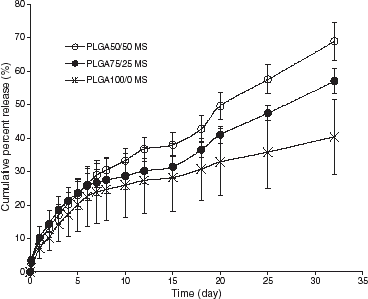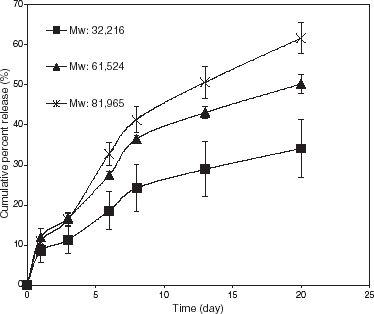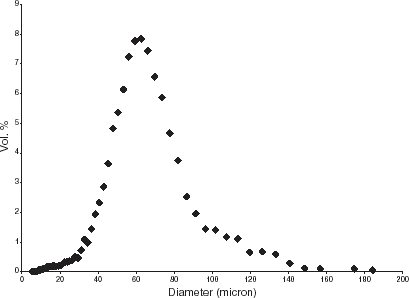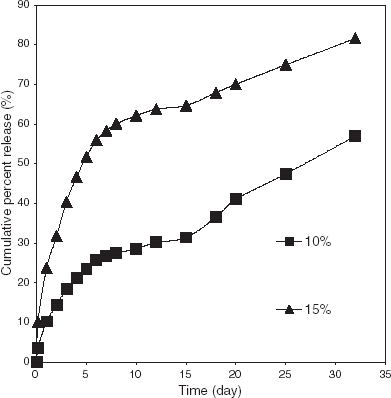Abstract
Lactic/glycolic acid polymers (PLGA) are widely used for drug delivery systems. The microsphere formulation is the most interesting dosage form of the PLGA-based controlled release devices. In this study, the previously reported PLGA were used to prepare drug-containing microspheres. Progesterone was used as a model drug. The progesterone microspheres were prepared from PLGA having varied compositions and varied molecular weight. The microscopic characterization shows that the microspheres are spherical, nonaggregated particles. The progesterone-containing PLGA microspheres possess a Gaussian size distribution, having average size from 70–134 µm. A solvent extraction method was employed to prepare the microspheres. The microencapsulation method used in this study has high drug encapsulation efficiency. The progesterone release from the PLGA microspheres and the factors affecting the drug release were studied. The release of progesterone from the PLGA microspheres is affected by the properties of the polymer used. The drug release is more rapid from the microspheres prepared using the PLGA having higher fraction of glycolic acid moiety. The drug release from the microspheres composed of higher molecular weight PLGA is faster. The drug content in microspheres also has an effect on the drug release. Higher progesterone content in microspheres yields a quicker initial burst release of the drug.
Introduction
Lactic/glycolic acid polymers (PLGA) are biocompatible, biodegradable, and bioabsorbable. They undergo biodegradation in the body. Their biodegradation products are normal body metabolites, which are nontoxic, nonimmunogenic, noncarcinogenic, and nonteratogenic (Wu, [Citation1995a]). The biodegradation products are eliminated from the body by entering the tricarboxylic acid cycle and/or by kidney excretion (Brady et al., [Citation1973]; Hockaday et al., [Citation1965]). Lactic/glycolic acid polymers have become increasingly important in the development of drug delivery systems. These polymers can either function as a matrix to control diffusion of the drug, followed by polymer biodegradation and elimination of the degradation products from the body, or they can participate in and control the rate of drug release by polymer hydration and degradation (Dunn et al., [Citation1988]).
Many types of drug delivery devices based on PLGA have been investigated. These drug delivery devices include microspheres (Arshady, [Citation1991]; Jalil and Nixon, [Citation1990a]), implantable rods (Fukuzaki et al., [Citation1991]; Sampath et al., [Citation1992]), fibers (Dunn et al., [Citation1981], [Citation1982]), films (Agarwal et al., [Citation1993]; Spilizewski et al., [Citation1987]), tablets (Omelczuk and McGinity, [Citation1993]), pellets (Marcotte and Goosen, [Citation1989]), beads (Ike et al., [Citation1992]), nanoparticles (Julienne et al., [Citation1992]), and others. Of all these, the injectable microspheres have been the major focus of research. Microspheres have some advantages over other devices. Ease of fabrication with good reproducibility, ease of incorporation of various kinds of drugs, ease of administration, and controllable drug release behavior are examples. Therefore, microspheres have been chosen as the dosage form, in this investigation, to study drug delivery application of the PLGA synthesized and reported previously (Wang et al., [Citation2000]; Wu, [Citation2001]).
Lactic/glycolic acid polymers microspheres are polymeric particles having a size range from a few micrometers to hundreds of micrometers and can be administered by needle injections via intramuscular, subcutaneous, intravenous, or intraperitoneal routes. However, the most interesting routes have been intramuscular and subcutaneous as they have good potential for extended release applications. The desired size range for intramuscular and subcutaneous injections is from several micrometers to several hundred micrometers. For intravenous administration, a microsphere size of 3–8 µm is desirable to prevent capillary clogging and phagocytosis (Gardner and Fink, [Citation1980]). PLGA microspheres that release a drug in a controlled manner can provide added value to drugs having a short biological half-life, instability, degradability in gastrointestinal tract, and high toxicity.
A large number of drugs have been encapsulated in PLGA microspheres. These drugs can be classified as small molecule drugs, peptide drugs, and protein drugs. In this study, a small molecule drug, progesterone, was used as a model drug. Progesterone-containing microspheres were prepared from PLGA having varied compositions and varied molecular weight using a solvent extraction method (Wu, [Citation1995b]). The microspheres were characterized with regards to microscopic characters, size and size distribution, and drug encapsulation efficiency. The progesterone release from the PLGA microspheres and the factors affecting the drug release were also investigated.
Materials and Methods
Materials
Progesterone was purchased from Sigma (Sigma Chemical Co., St. Louis, MO). A series of PLGA having various molar ratios of lactic to glycolic acid moiety and another series of PLGA having various molecular weights were synthesized in our laboratory as described in previous papers (Wang et al., [Citation2000]; Wu, [Citation2001]). All other chemicals used were obtained from Acros Organics (Fisher Scientific, Pittsburgh, PA). All solvents were supplied by EM Science (EM Science, Gibbstown, NJ).
Preparation of Progesterone-containing PLGA Microspheres
The progesterone-containing PLGA microspheres were prepared using a solvent extraction method (Wu, [Citation1995b]). A total weight of 1 g PLGA and progesterone was dissolved in 8 mL methylene chloride to make a polymer-drug solution. For example, 0.9 g PLGA and 0.1 g progesterone were used for 10% drug-containing microspheres while the proportional ratio of PLGA and progesterone was kept for the other microspheres. The drug containing polymer solution was added to 100 mL aqueous solution containing 0.5 wt.% poly(vinyl alcohol). An oil-in-water (o/w) emulsion was formed under stirring (400 rpm). After stirring for 1 min, the o/w emulsion was transferred into 1.8 L distilled water to extract the polymer solvent (methylene chloride) at ∼4°C. Consequently, the microspheres were hardened. The microspheres were extracted/hardened for 2 h and collected by filtration using Whatman #1 filter paper. The collected microspheres were dried in vacuo and kept in the refrigerator for further investigations.
Characterization of the Progesterone-containing PLGA Microspheres
Microscopic Observation
The prepared progesterone-containing PLGA microspheres were observed using an optical microscope (Nikon Optiphot biological microscope, Model M-35S). Polaroid pictures were taken from the microscope during the examination.
Size and Size Distribution Measurement
The progesterone-containing PLGA microspheres, 5 mg, were suspended in 2 mL aqueous solution of 1% Tween 80 by sonicating the suspension for 10 s in a bath sonicator (Braun Biotech, Inc., Allentown, PA). The suspension was then evaluated using an optical particle sizer (Accusizer, Model 770, Santa Barbara, CA). Average size and size distribution of the microspheres were obtained from this study.
Drug Content and Encapsulation Efficiency Determination
The progesterone-containing PLGA microspheres, 5 mg, were accurately weighed and dissolved in 4 mL acetonitrile. The resulting solution was filtered through a 0.22 µm PTFE syringe filter and analyzed by using a HPLC system. The system was composed of a pump (Hitachi L-6200A Intelligent Pump) and a detector (Spectra 100 variable wavelength detector, Spectra-Physics). A µBondapak C18 column (3.9 × 300 mm, Waters Corporation, Milford, MA, USA) was used and maintained at room temperature. The wavelength was 254 nm. The flow rate was 1.5 mL/min. The mobile phase was a mixture of methanol and water (methanol:water = 70:30). The injection volume was 20 µL. The amount of progesterone for each injection was calculated using a calibration line. The calibration line was established using a series of progesterone solutions with known concentration. The encapsulation efficiency of progesterone was then calculated using the following equation:where Ma is the actual amount of progesterone encapsulated in the microspheres that was determined by using the HPLC method and Mo is the theoretical or feeding amount of progesterone added to the recipe during the microsphere formulation process. Three parallel measurements were conducted for each sample to calculate the drug encapsulation efficiency.
In Vitro Study of Progesterone Release from the PLGA Microspheres
The progesterone-containing PLGA microspheres, 10 mg, were suspended in 2 mL PBS (20 mM, pH 7.4, containing 20 vol.% methanol) in 8 mL capped glass vials. The methanol was added to the PBS to accelerate progesterone release and to obtain the desired solubility of progesterone. The vials were incubated in a 37°C shaker bath shaking at 50 rpm. At predetermined time intervals, the vials were taken out of the shaking bath and stood still for a few minutes to allow the microspheres to sink down. Then, 1 mL of the supernatant was withdrawn and the same amount of fresh methanol-containing PBS was added. The vials were returned to the shaking bath. The withdrawn solution samples were analyzed by using the HPLC system and the method described above. This set of experiments was conducted in triplicate. The amount of progesterone released was calculated by using the following equation:where Mt is the amount of progesterone released into the buffer after the microspheres were incubated in the methanol-containing PBS for t days and Ma is the actual amount of progesterone encapsulated in the microspheres as described above.
Results
Preparation of the Progesterone-containing PLGA Microspheres
There are many kinds of method that can be used to prepare PLGA microspheres. These methods include solvent extraction, solvent evaporation, phase separation, (water-in-oil)-in-water multiple emulsion, spray drying, supercritical fluid extraction, and other methods. Solvent extraction, solvent evaporation, and phase separation are the main processes used to prepare PLGA microspheres. The solvent extraction and the solvent evaporation procedures are aqueous-system processes while the phase separation procedure is a nonaqueous process. It follows that the solvent extraction and solvent evaporation methods are suitable for water-insoluble drugs whereas the phase separation method is preferable for water-soluble drugs. Therefore, these processes are complementary in that the limitation of one method may be circumvented by using the others. Because progesterone is a water-insoluble drug, solvent extraction method is selected for the microencapsulation in this investigation. This microencapsulation method has been widely used for microencapsulation of hydrophobic drugs in the pharmaceutical field (Lewis, [Citation1990]). This method has an advantage of mild encapsulation condition.
The solvent extraction method is essentially an oil-in-water (o/w) dispersion or emulsion process. An organic phase containing a PLGA and the drug is mixed in an aqueous phase containing an emulsifier. The emulsified organic droplets containing the polymer and the drug are then hardened into microspheres by removing the organic solvent through a water extraction. Operations of the solvent extraction method used in this study are sketched schematically in .
Figure 1. A schematic illustration of the solvent extraction method used for preparation of the progesterone-containing PLGA microspheres.

Although the solvent extraction process for making the microspheres is conceptually simple, in fact, a variety of variables influence microsphere formation and drug release. These variables include the polymer composition and molecular weight, the nature and solubility of the drug, the organic solvent used, the temperature of the emulsion, the volume of the organic phase per unit volume of aqueous phase, and the physicochemical properties and amount of emulsifier used (Thies and Bissery, [Citation1984]). In this study, most of these variables were well controlled as discussed above. Some other parameters were varied and their effects on microspheres and drug release are discussed below.
Microscopic Characteristics of the Progesterone-containing PLGA Microspheres
Microscopy is a basic tool commonly used to study PLGA microspheres. This tool reveals information on microsphere surface quality, shape, aggregation, and size and size distribution. is a typical micrograph showing the progesterone-containing PLGA microspheres. The microspheres possess a spherical shape. They are translucent, which indicates the homogeneity of drug distribution. There is no indication of microsphere aggregation, which presents the suitability of the solvent extraction method used for the microencapsulation of progesterone.
Size and Size Distribution of the Progesterone-containing PLGA Microspheres
Many factors can affect the size and size distribution of microspheres when the solvent extract method is used for the microencapsulation. Stir speed during emulsification, properties of the PLGA used, polymer concentration, emulsifier concentration, solvent used, volume ratio of polymer-containing phase to nonpolymer-containing phase(s), viscosity of each phase, and other parameters all have an effect. The number-weighted and volume-weighted average size of some batches of the progesterone-containing PLGA microspheres is listed in Tables and . As can be seen in , the polymer composition does not have an obvious effect on the size of the microspheres. However, the polymer molecular weight has an influence on the size of the microspheres (). As shown in , the volume-average size of the microspheres increased from ∼70 to 134 µm when the molecular weight of the polymer increases. This is due to the fact that the viscosity of the polymer solution is increased as the molecular weight of the polymer increases. Under the same stirring rate, during the microsphere preparation, the size of the microspheres increases when viscosity of the polymer solution increases.
Table 1. Effect of polymer composition on size of the progesterone-containing PLGA microspheres
Table 2. Effect of polymer molecular weight on size of the progesterone-containing PLGA microspheres
A typical size distribution curve of the progesterone-containing PLGA microspheres is shown in . As one can see, the size distribution of the microspheres exhibits a normal or Gaussian distribution pattern, which is a typical distribution generated by the mechanical stirring used in this study.
Drug Content and Encapsulation Efficiency of the Progesterone-containing PLGA Microspheres
During the process of forming drug-loaded microspheres of PLGA, the drug is often lost to some extent, and a 100% encapsulation efficiency of any drug is unlikely (Wang et al., [Citation1991]). The encapsulation efficiency can be influenced by the solubility of a drug in the organic and aqueous phases, the partition coefficient of the drug between polymer-containing and nonpolymer-containing phases, the viscosity of the different phases, the microsphere size, and the nature and concentration of emulsifiers (Fong, [Citation1988]). The drug content and the encapsulation efficiency of some batches of the progesterone-containing PLGA microspheres are shown in Tables and . The encapsulation efficiency of the prepared microspheres is all above 80%. The polymer composition of the PLGA used does not have an effect on the drug encapsulation efficiency (). The polymer molecular weight, however, has an obvious effect on the drug encapsulation efficiency. As can be seen in , the encapsulation efficiency increases from 80.97 to 101.87% as polymer molecular weight of the PLGA increases from 12,459 Dalton to 116,470 Dalton. This effect is mainly attributed to the viscosity change of the polymer solution. The viscosity of the polymer solution increases as the molecular weight of the polymer increases. The high viscosity of the polymer solution can slow down the drug diffusion rate from the PLGA droplets/matrices, which reduces the drug diffusion into the surrounding aqueous solutions. As a consequence, the encapsulation efficiency increases.
Table 3. Effect of polymer composition on drug encapsulation efficiency of the progesterone-containing PLGA microspheres
Table 4. Effect of polymer molecular weight on drug encapsulation efficiency of the progesterone-containing PLGA microspheres
In Vitro Progesterone Release from the PLGA Microspheres
There are many parameters that influence drug release from PLGA microspheres. Polymer properties such as composition and molecular weight, drug content in the microspheres and microencapsulation conditions all affect drug release.
The polymer composition (ratio of lactic to glycolic acid moiety) influences the pattern of progesterone release from the PLGA microspheres (). As shown in , progesterone is released faster from microspheres prepared using polymers containing a higher fraction of glycolic acid moiety.
Figure 4. Effect of polymer composition (molar ratio of lactic to glycolic acid moiety) on progesterone release from the PLGA microspheres. (Molecular weight of the PLGA: 11,351–14,914 Dalton; Theoretical/feeding drug content: 10% by weight).

The molecular weight of PLGA has a great effect on the rate and duration of drug release (Asano et al., [Citation1990]). As shown in , one can see that the progesterone release from the PLGA microspheres prepared using low molecular weight polymers is slower than that from the PLGA microspheres prepared using high molecular weight polymers.
Figure 5. Effect of polymer molecular weight on progesterone release from the PLGA microspheres. (Polymer composition: molar ratio of lactic to glycolic acid moiety = 75:25; Theoretical/feeding drug content: 10% by weight).

The drug content or concentration in a microsphere formulation has a considerable effect on drug release from PLGA microspheres. As shown in , the progesterone release from the microspheres having 20% drug content is faster than that from those having 15% drug content.
Discussion
Progesterone-containing microspheres were prepared using lactic/glycolic acid polymers produced and reported in the previous publication. The microscopic characterization shows that the microspheres are spherical, nonaggregated particles. The progesterone-containing PLGA microspheres possess a normal or Gaussian size distribution, having average size from 70 to 134 µm. Solvent extraction method was employed for the preparation of the progesterone-containing PLGA microspheres. This microencapsulation method has high drug encapsulation efficiency.
Study of progesterone release from the PLGA microspheres reveals the following facts. The release of progesterone from the PLGA microspheres is affected by the properties of the polymer used. The drug release is more rapid from the microspheres prepared using the PLGA having higher fraction of glycolic acid moiety. This is due to a number of polymer properties including hydrophobicity, water uptake ability, swelling ratio, crystallinity, glass transition temperature, biodegradation rate, and permeability to the drug (Pitt et al., [Citation1979]). The PLGA containing higher fraction of glycolic acid moiety are more hydrophilic and hydrate and swell faster, which is favorable to drug release. In addition, the polymers containing higher fraction of glycolic acid moiety degrade faster, which also makes the drug release faster.
The drug release from the microspheres composed of higher molecular weight PLGA is faster. This can be explained by the following reasons. The low molecular weight polymers have better solubility in the solvent than their high molecular weight counterparts. Consequently, when the microspheres are hardened in the hardening solutions, the precipitation of high molecular weight polymers is faster than that of low molecular weight polymers. A fast polymer precipitation produces more porous matrices than a slow polymer precipitation. The high molecular weight polymers form rigid polymer chains when the polymer solubility is reduced. The rigid polymer chains generate loose precipitates in the hardening solutions while their low molecular weight counterparts produce dense precipitates. Thus, the low molecular weight polymers form denser, more uniform microspheres than the high molecular weight polymers, and consequently release fewer drugs than their more porous counterparts (Jalil and Nixon, [Citation1990b]).
The drug content in microspheres also has an effect on the drug release. Higher drug content in microspheres leads to a quicker initial burst release of the drug. The higher drug content yields relatively more drug molecules on or near the surface of the microspheres, which can be confirmed by the more rapid initial burst release from the microspheres having 20% drug content. After the burst release phase lasting approximately for a week, the progesterone release rate from these two batches of PLGA microspheres is nearly the same.
Acknowledgments
The author wishes to thank N. Wang and C. Li for their support in conducting the experiments.
References
- Agarwal R. K., Robinson D. H., Maze G. I., Reinhardt R. A. Development and characterization of tetracycline-poly(lactide/glycolide) films for the treatment of periodontitis. J. Controlled Rel. 1993; 23: 137–147
- Arshady R. Preparation of biodegradable microspheres and microcapsules: 2. Polylactides and related polyesters. J. Controlled Rel. 1991; 17: 1–12
- Asano M., Fukuzaki H., Yoshida M., Kumakura M., Mashimo T., Yuasa H., Imai K., Yamanaka H. Application of poly DL-lactic acids of varying molecular weight in drug delivery systems. Drug Design Deliv. 1990; 5: 301–320
- Brady J. M., Cutright D. E., Miller R. A., Battistone G. C. Resorption rate, route of elimination and ultrastucture of the implant site of poly(lactic acid) in the abdominal wall of the rat. J. Biomed. Mater. Res. 1973; 7: 155–166
- Dunn R. L., Lewis D. H., Beck L. R. Fibrous polymers for the delivery of contraceptive steroids to the female reproductive tract. Controlled Release of Pesticides and Pharmaceuticals, D.H. Lewis. Plenum Publishing Corporation, New York 1981; pp. 125–164
- Dunn R. L., Lewis D. H., Goodson J. M. Monolithic fibers for controlled delivery of tetracycline. Proceed. Intern. Symp. Control. Rel. Bioact. Mater. 1982; 9: 157–159
- Dunn R. L., English J. P., Strobel J. D., Cowsar D. R., Tice T. R. Preparation and evaluation of lactic/glycolic acid copolymers for drug delivery. Polymers in Medicine, C. Migliaresi. Elsevier Science Publishers, Amsterdam, The Netherlands 1988; Vol. 3: pp. 149–160
- Fong J. W. Microencapsulation by solvent evaporation and organic phase separation processes. Controlled Release Systems: Fabrication Technology, D. Hsieh. CRC Press, Inc., Boca Raton, FL 1988; Vol. 1: pp. 81–108
- Fukuzaki H., Yoshida M., Asano M., Kumakura M., Mashimo T., Yuasa H., Imai K., Yamanaka H. In vivo characteristics of high molecular weight copoly(l-lactide/glycolide) with S-type degradation pattern for application in drug delivery systems. Biomaterials 1991; 12: 433–437
- Gardner D. L., Fink D. J. Biodegradable microcapsules and microparticles for contraceptions. Progress in Contraceptive Delivery Systems. Biodegradables and Delivery Systems for Contraception, E. S. E. Hafez, W. A. A. van Os. MTP Press Ltd., LancasterEngland 1980; Vol. 1: pp. 47–62
- Hockaday T. D. R., Frederick E. W., Clayton J. E., Smith L. H., Jr. Studies on primary hyperoxaluria. II. Urinary oxalate, glycolate, and glyoxylate measurement by isotope dilution methods. J. Lab. Clin. Med. 1965; 65: 677–687
- Ike O., Shimizu Y., Wada R., Hyon S. H., Ikada Y. Controlled cisplatin delivery system using poly(d,l-lactic acid). Biomaterials 1992; 13: 230–234
- Jalil R., Nixon J. R. Biodegradabale poly(lactic acid) and poly(lactide-co-glycolide) microcapsules: problems associated with preparative techniques and release properties. J. Microencapsulation 1990a; 7: 297–325
- Jalil R., Nixon J. R. Microencapsulation using poly(l-lactic acid). IV. Release properties of microcapsule containing phenobarbitone. J. Microencapsulation 1990b; 7: 53–66
- Julienne M. C., Alonso M. J., Gomez Amoza J. L., Benoit J. P. Preparation of poly(d,l-lactide/glycolide) nanoparticles of controlled particle size distribution: application of experimental designs. Drug Develop. Industr. Pharm. 1992; 18: 1063–1077
- Lewis D. H. Controlled release of bioactive agents from lactide/glycolide polymers. Biodegradable Polymers as Drug Delivery Systems, M. Chasin, R. Langer. Marcel Dekker, Inc., New York 1990; pp. 1–41
- Marcotte N., Goosen M. F. A. Delayed release of water-soluble macromolecules from polylactide pellets. J. Controlled Release 1989; 9: 75–85
- Omelczuk M., McGinity J. W. The influence of thermal treatment on the physical-mechanical and dissolution properties of tablets containing poly(d,l-lactic acid). Pharm Res. 1993; 10: 542–548
- Pitt C. G., Gratzl M. M., Jeffcoat A. R., Zweidinger R., Schindler A. Sustained drug delivery systems. II. Factors affecting release rates from poly(ε-caprolactone) and related biodegradable polyesters. J. Pharm. Sci. 1979; 68: 1534–1538
- Sampath S. S., Garvin K., Robinson D. H. Preparation and characterization of biodegradable poly(l-lactic acid) gentamicin delivery systems. Intern. J. Pharm. 1992; 78: 165–174
- Spilizewski K. L., Marchant R. E., Hamlin C. R., Anderson J. M., Tice T. R., Dappert T. O., Meyer W. E. The effect of hydrocortisone acetate loaded poly(d,l-lactide) films on the inflammatory response. Advances in Drug Delivery Systems, J. M. Anderson, S. W. Kim. Elsevier Scientific Publishing, AmsterdamThe Netherlands 1987; Vol. 3: pp. 197–203
- Thies C., Bissery M. C. Biodegradable microspheres for parenteral administration. Biomedical Applications of Microencapsulation, F. Lim. CRC Press, Inc., Boca Raton, FL 1984; pp. 53–74
- Wang H. T., Schmitt E., Flanagan D. R., Linhardt R. J. Influence of formulation methods on the in vitro controlled release of protein from poly(ester) microspheres. J. Controlled Rel. 1991; 17: 23–32
- Wang N., Wu X. S., Li C., Feng M. F. Synthesis, characterization, biodegradation, and drug delivery application of biodegradable lactic/glycolic acid polymers. Part I. Synthesis and characterization. J. Biomater. Sci.: Polym. Ed. 2000; 11(3)301–318
- Wu X. S. Synthesis and properties of biodegradable lactic/glycolic acid polymers. Encyclopedic Handbook of Biomaterials and Bioengineering, Part A: Materials, D. L. Wise, D. J. Trantolo, D. E. Altobelli, M. J. Yaszemski, J. D. Gresser, E. R. Schwartz. Marcel Dekker, Inc., New York 1995a; Vol. 2: pp. 1015–1054
- Wu X. S. Preparation, characterization, and drug delivery applications of microspheres based on biodegradable lactic/glycolic acid polymers. Encyclopedic Handbook of Biomaterials and Bioengineering, Part A: Materials, D. L. Wise, D. J. Trantolo, D. E. Altobelli, M. J. Yaszemski, J. D. Gresser, E. R. Schwartz. Marcel Dekker, Inc., New York 1995b; pp. 1151–1200
- Wu X. S. Synthesis, characterization, biodegradation, and drug delivery application of biodegradable lactic/glycolic acid polymers. Part II. Biodegradation. J. Biomater. Sci.: Polym. Ed. 2001; 12(1)21–34


